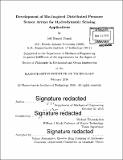| dc.contributor.advisor | Michael Triantafyllou. | en_US |
| dc.contributor.author | Dusek, Jeff Ernest | en_US |
| dc.contributor.other | Massachusetts Institute of Technology. Department of Mechanical Engineering. | en_US |
| dc.date.accessioned | 2016-07-01T18:45:37Z | |
| dc.date.available | 2016-07-01T18:45:37Z | |
| dc.date.copyright | 2016 | en_US |
| dc.date.issued | 2016 | en_US |
| dc.identifier.uri | http://hdl.handle.net/1721.1/103496 | |
| dc.description | Thesis: Ph. D., Massachusetts Institute of Technology, Department of Mechanical Engineering, 2016. | en_US |
| dc.description | Cataloged from PDF version of thesis. | en_US |
| dc.description | Includes bibliographical references (pages 277-284). | en_US |
| dc.description.abstract | The performance of marine vehicles is largely influenced by interactions with the flow around their hull, both self-generated and environmentally driven. To improve performance through flow control, a detailed, real-time measurement of the near-field flow is necessary, yet such sensing capability is presently unavailable. Looking to nature for inspiration, fish employ the distributed pressure and velocity sensing capability of their lateral line sensory organ to mediate navigation and control behaviors that, if replicated, could benefit engineered systems. Through a series of towing tank and field experiments, it was found that while distributed pressure measurements on marine vehicles enabled the detection of near-body flow phenomena, the size, cost, and mounting requirements of commercial sensors lead to sparse arrays and substantial gaps in the characterization of the flow field. To address the challenges associated with obtaining spatially-dense pressure measurements on curved surfaces in marine environments, a new waterproof and conformal pressure sensor array was developed based on a closed-cell piezo resistive foam composed of carbon black-doped-silicone composite (CBPDMS foam). The response of the CBPDMS foam sensor arrays was characterized using periodic hydrodynamic pressure stimuli from vertical plunging and water waves, and a piecewise polynomial calibration was developed to describe the sensor response. The sensitivity and frequency response of the sensor arrays was also documented through a series of biologically-inspired hydrodynamic stimuli, including the flow from a dipole source, and the Karmin vortical wake flow behind a circular cylinder. The CBPDMS foam sensor arrays have significant advantages over existing commercial sensors for distributed flow reconstruction and control. They are found to have sensitivity on the order of 5 Pascal, frequency range of 0.5-35 Hertz, are contained in a waterproof and completely flexible package, and have material cost less than $10 per sensor. | en_US |
| dc.description.statementofresponsibility | by Jeff Ernest Dusek. | en_US |
| dc.format.extent | 284 pages | en_US |
| dc.language.iso | eng | en_US |
| dc.publisher | Massachusetts Institute of Technology | en_US |
| dc.rights | M.I.T. theses are protected by copyright. They may be viewed from this source for any purpose, but reproduction or distribution in any format is prohibited without written permission. See provided URL for inquiries about permission. | en_US |
| dc.rights.uri | http://dspace.mit.edu/handle/1721.1/7582 | en_US |
| dc.subject | Mechanical Engineering. | en_US |
| dc.title | Development of bio-inspired distributed pressure sensor arrays for hydrodynamic sensing applications | en_US |
| dc.type | Thesis | en_US |
| dc.description.degree | Ph. D. | en_US |
| dc.contributor.department | Massachusetts Institute of Technology. Department of Mechanical Engineering | |
| dc.identifier.oclc | 952423950 | en_US |
